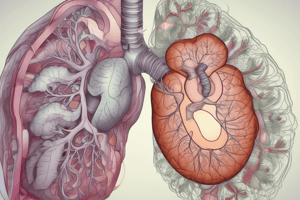Podcast
Questions and Answers
Which type of breath sound is characterized by louder, harsher, and higher-pitched sounds with a short silence between inspiratory and expiratory sounds?
Which type of breath sound is characterized by louder, harsher, and higher-pitched sounds with a short silence between inspiratory and expiratory sounds?
- Vesicular
- Tracheal
- Bronchovesicular
- Bronchial (correct)
Which type of breath sound is soft and low-pitched, heard throughout inspiration, continues without pause through expiration, and then fades away about one third of the way through expiration?
Which type of breath sound is soft and low-pitched, heard throughout inspiration, continues without pause through expiration, and then fades away about one third of the way through expiration?
- Bronchial
- Bronchovesicular
- Tracheal
- Vesicular (correct)
Which breath sound type has inspiratory and expiratory sounds about equal in length, at times separated by a silent interval, with detecting differences in pitch and intensity often easier during expiration?
Which breath sound type has inspiratory and expiratory sounds about equal in length, at times separated by a silent interval, with detecting differences in pitch and intensity often easier during expiration?
- Bronchial
- Bronchovesicular (correct)
- Tracheal
- Vesicular
What type of breath sound is characterized by loud, harsh sounds heard over the trachea in the neck?
What type of breath sound is characterized by loud, harsh sounds heard over the trachea in the neck?
What should be watched for in cold or tense patients, which may present as muscle contraction sounds—muffled, low-pitched rumbling, or roaring noises?
What should be watched for in cold or tense patients, which may present as muscle contraction sounds—muffled, low-pitched rumbling, or roaring noises?




